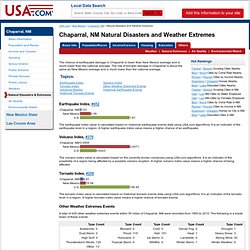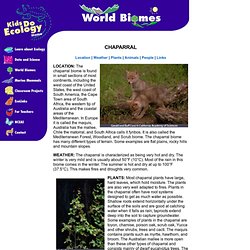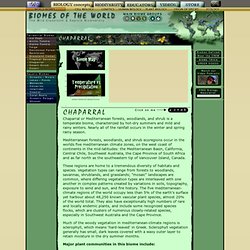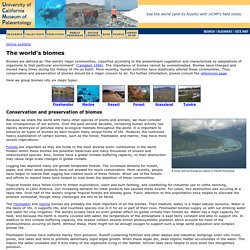

Chaparral. [Biomes - Living Worlds] As of July 1, 2013 ThinkQuest has been discontinued.
![[Biomes - Living Worlds]](http://cdn.pearltrees.com/s/pic/th/thinkquest-28536000)
We would like to thank everyone for being a part of the ThinkQuest global community: Students - For your limitless creativity and innovation, which inspires us all. Teachers - For your passion in guiding students on their quest. Partners - For your unwavering support and evangelism. Parents - For supporting the use of technology not only as an instrument of learning, but as a means of creating knowledge. Chaparral, NM Natural Disasters and Weather Extremes. Hot Rankings High / Low NM Cities by Males Employed High / Low NM Cities by Females Employed The chance of earthquake damage in Chaparral is lower than New Mexico average and is much lower than the national average.

The risk of tornado damage in Chaparral is about the same as New Mexico average and is much lower than the national average. Earthquake Index, #452 The earthquake index value is calculated based on historical earthquake events data using USA.com algorithms. KDE Santa Barbara. Location | Weather | Plants | Animals | People | Links LOCATION: The chaparral biome is found in small sections of most continents, including the west coast of the United States, the west coast of South America, the Cape Town area of South Africa, the western tip of Australia and the coastal areas of the Mediterranean.

In Europe it is called the maquis, Australia has the mallee, Chile the matorral, and South Africa calls it fynbos. It is also called the Mediterranean Forest, Woodland, and Scrub biome. The chaparral biome has many different types of terrain. Some examples are flat plains, rocky hills and mountain slopes. WEATHER: The chaparral is characterized as being very hot and dry. PLANTS: Most chaparral plants have large, hard leaves, which hold moisture. ANIMALS: The animals are all mainly grassland and desert types adapted to hot, dry weather. Chaparral (Mediterranean) Biome. Chaparral or Mediterranean forests, woodlands, and shrub is a temperate biome, characterized by hot-dry summers and mild and rainy winters.

Nearly all of the rainfall occurs in the winter and spring rainy season. Mediterranean forests, woodlands, and shrub ecoregions occur in the worlds five mediterranean climate zones, on the west coast of continents in the mid-latitudes: the Mediterranean Basin, California, Central Chile, Southwest Australia, the Cape Province of South Africa and as far north as the southeastern tip of Vancouver Island, Canada.
These regions are home to a tremendous diversity of habitats and species. Vegetation types can range from forests to woodlands, savannas, shrublands, and grasslands; "mosaic" landscapes are common, where differing vegetation types are interleaved with one another in complex patterns created by variations in soils, topography, exposure to wind and sun, and fire history. Major plant communities in this biome include: Text is temporary. Define Chaparral at Dictionary. Chaparral. Chaparral. Chaparral Red shanks chaparral Photo by Rick Halsey Chaparral is California’s most extensive plant community.

It is also the state’s most characteristic wilderness, dominating foothills and mountain slopes from the Rouge River Valley in southern Oregon to the San Pedro Martir in Baja California. Properly defined, chaparral is a semi-arid, shrub dominated association of sclerophyllous (“hard-leaved”), woody plants shaped by summer drought, mild, wet winters, and naturally recurring fires every 30 to 150 years plus. Sclerophyllous leaves are advantageous in a semi-arid climate because they reduce evaporation thorough a variety of traits including waxy coatings, thicker cell layers, and recessed stomata, the pores in leaves permitting evaporation and the exchange of oxygen and carbon dioxide. chamise (greasewood) Photos by Michael Simpson ceanothus (wild lilac) red shanks Chaparral plants employ four different strategies in response to drought.
Manzanita Photos by Michael Simpson toyon bobcat. Chaparral Animal Printouts. Chaparral. What are Biomes? As of July 1, 2013 ThinkQuest has been discontinued.

We would like to thank everyone for being a part of the ThinkQuest global community: Students - For your limitless creativity and innovation, which inspires us all. Teachers - For your passion in guiding students on their quest. Partners - For your unwavering support and evangelism. Parents - For supporting the use of technology not only as an instrument of learning, but as a means of creating knowledge. Chaparral Facts. Biomes. A biome is a large, distinctive complex of plant communities created and maintained by climate.

How many biomes are there? A study published in 1999 concluded that there are 150 different "ecoregions" in North America alone. But I shall cast my lot with the "lumpers" rather than the "splitters" and lump these into 8 biomes: The figure shows the distribution of these 8 biomes around the world. A number of climatic factors interact in the creation and maintenance of a biome. Where precipitation is moderately abundant — 40 inches (about 1 m) or more per year — and distributed fairly evenly throughout the year, the major determinant is temperature. Whether it ever freezes; length of the growing season If there is ample rainfall, we find 4 characteristic biomes as we proceed from the tropics (high temperatures) to the extreme latitudes (low temperatures).
Tropical Rain Forest. Chaparral Biome - Facts and Information - The Portal of Life. The chaparral biome is one that is found in areas of every single continent.

However, many people don’t realize it is the same. That is because there are several different types of terrain that this particular biome is associated with. In some areas they are flat plains but in other regions there are hills. Still yet, others consist of mountain terrain areas. They really are lovely areas with lots to offer. A chaparral biome is created when cool water from an ocean merges with a landmass that is at a high temperature. With a chaparral biome you will find that there is a very wet winter and also a very dry summer. These fires are usually the result of lightning striking in the area. The fact that many homes have been built on the edges of these biomes such as in California, it can be a huge threat when such fires break out. Chaparral. Chaparral, Santa Ynez Mountains, near Santa Barbara, California Introduction[edit] In its natural regime, chaparral is characterized by infrequent fires, with intervals ranging between 10–15 years to over a hundred years.

The world's biomes. Online exhibits.

Chaparral Country Wildlife, Animal Species. California Montane Chaparral & Woodlands © 2005 Natasha Sherman Name for the Spanish for "scrub oak", the chaparral is a unique plant community, most prominent on hot, dry California slopes. Chaparral is a mixture of various evergreen shrubs, some of them bushy versions of trees found in nearby woodlands. With roots that tap deep sources of water, the shrubs can survive on parched soil. Though winter rains bring on a season of bloom, the waxy leaves turn dry as tinder during the long, hot summer. Fire sweeps periodically through the chaparral.
Chaparral forms dense thickets nearly impenetrable to man or large animals. The Mediterranean Biome. The Mediterranean Biome This biome actually goes by several names. It is found surrounding large parts of the Mediterranean Sea and is thus sometimes called the Mediterranean Biome, others call it a Woodland Biome, while others call it a Shrub or Chaparral Biome. Chaparral Community near Malibu, California In the "modified" Whittaker diagram shown here, the woodland/shrubland biome is found from areas with just over 100mm of rain per year to around 20 mm of rain per year; average annual temperatures range from below zero to about 20 C. Looking at the map below, however, it is hard to imagine any of those sites being as cold as this diagram would seem to indicate.
As already mentioned, this biome is most frequent from 30 to 40 north or south latitude (see map). Plants adapted to this biome tend to be less than a meter tall, and relatively shrubby in appearance. Blue Planet Biomes - World Biomes. What is a Biome? A biome is a large geographical area of distinctive plant and animal groups, which are adapted to that particular environment. The climate and geography of a region determines what type of biome can exist in that region.